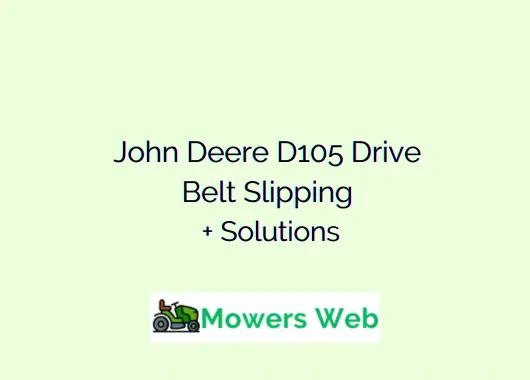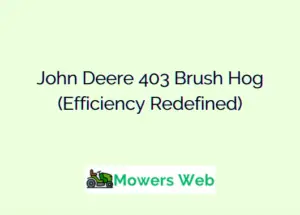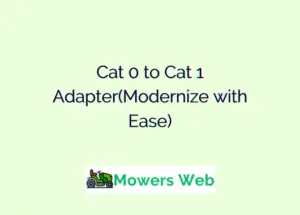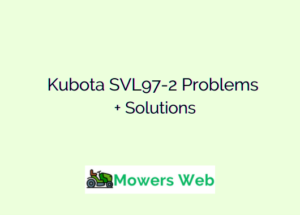One of the common issues with the John Deere D105 you might encounter is the drive belt slipping. This problem can hamper the efficiency of your mower and leave your lawn looking less than perfect.
In this post, we’ll dive into the reasons behind drive belt slipping and provide you with practical solutions to keep your John Deere D105 running smoothly.
Let’s jump in.
John Deere D105 Drive Belt Slipping
Why does it slip?
Drive belt slipping can occur for various reasons, and understanding these causes is crucial to diagnosing and fixing the issue.
1. Belt Tension
Belt tension refers to the amount of pressure or tightness in the drive belt. Over time and with regular use, the tension in the belt can decrease due to wear and tear.
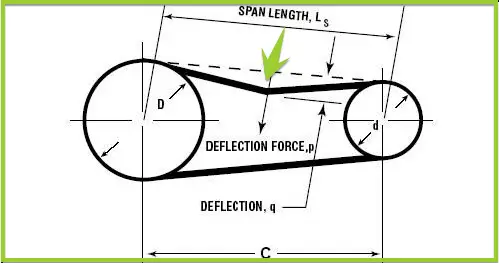
When the belt loses its tension, it may not grip the pulleys as effectively, leading to slipping.
Read How to Replace Mower Belt on John Deere D130 Diagram
2. Worn or damaged belt
As with any mechanical component, drive belts can wear out over time. Fraying, cracks, and other forms of damage can compromise the belt’s integrity.
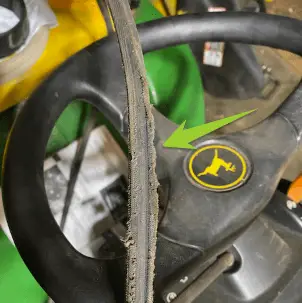
A worn or damaged belt is less capable of maintaining a strong grip on the pulleys, resulting in slipping issues.
3. Misaligned Pulleys
The pulleys on your John Deere D105 must be correctly aligned to ensure that the drive belt runs smoothly. If the pulleys become misaligned, the belt can wander off track, causing it to lose traction and slip.

Read Where does the Spring go on a Mower Deck(Explained)
Troubleshooting D105 Drive Belt Slipping
1. Checking belt tension
Step 1: Inspect the Belt
Start by visually inspecting the drive belt. Look for signs of wear, such as fraying, cracks, or any visible damage. Additionally, check the overall tension of the belt.
Step 2: Tighten the Belt
If the belt appears loose, use the belt tension adjustment lever, usually located on the mower deck or engine, to increase the tension.
Read Husqvarna Z254F Drive Belt Tension Spring(Explained)
2. Replacing a Worn Belt
Step 1: Purchase a Replacement Belt
If your drive belt is worn or damaged beyond repair, purchase a replacement belt that is compatible with your specific D105 model. Using an authentic John Deere replacement belt is highly recommended.
Step 2: Remove the old belt
Follow the instructions outlined in your mower’s manual to safely remove the old, damaged belt. This typically involves loosening tension, detaching any securing mechanisms, and sliding the old belt off the pulleys.
Step 3: Install the New Belt
Carefully install the new belt, ensuring that it is correctly aligned with the pulleys. Refer to your manual for guidance on the specific installation process for your D105 model.
Read One Mower Blade Lower Than the Other(Fix this In 3 Steps)
3. Aligning Pulleys
Step 1: Inspect the Pulleys
Before attempting to align the pulleys, inspect them for any visible signs of misalignment or damage. Misaligned pulleys can cause the belt to deviate from its intended path.
Step 2: Adjust Pulley Alignment
To realign the pulleys, you may need to use wrenches, pliers, or other appropriate tools.
Refer to your John Deere D105 manual for detailed instructions on how to align the pulleys properly. Proper alignment ensures that the drive belt follows its intended path without slipping.
Read Can you Pulley swap a Hydrostatic Mower? (Explained)
Preventive Maintenance
Regular Inspections
Perform routine inspections of your drive belt and pulleys.
Start with a thorough check at the beginning of each mowing season and continue to inspect the components periodically throughout the year.
This proactive approach allows you to identify and address potential issues before they escalate.
Cleaning and Lubrication
Regular cleaning and lubrication of your mower’s moving parts are crucial to reducing friction and preventing premature wear on the drive belt.
Keep the mower deck clean and ensure that the pulleys and other components are well-lubricated according to the manufacturer’s recommendations.
Read Cub Cadet ZT1 Grease Points(7 Critical Points To Consider)
John Deere D105 drive belt diagram

Final Remarks
Addressing drive belt slipping in your John Deere D105 is essential to maintaining the efficiency and effectiveness of your lawn mower.
By understanding the causes, regularly inspecting and maintaining your drive belt and pulleys, and following proper troubleshooting steps, you can ensure that your mower runs smoothly, resulting in a well-kept lawn.
Read John Deere MFWD Problems(5 Easy Ways To Fix)
FAQs
How often should I check my drive belt tension?
Regularly inspect your drive belt tension at the start of each mowing season and periodically throughout the year. This proactive approach helps prevent slipping issues.
Can I use a generic belt as a replacement?
While it’s possible to use a generic belt as a replacement, it’s highly recommended to use an authentic John Deere replacement belt to ensure compatibility and optimal performance.
What tools do I need to align the pulleys?
To align the pulleys properly, you may need wrenches, pliers, and a belt tension gauge. Consult your John Deere D105 manual for specific tool requirements and instructions.
Is drive belt slipping covered by the warranty?
Drive belt issues may be covered under warranty if they result from manufacturing defects. Check your warranty documentation for specific coverage details and terms.
How can I prevent grass clippings from accumulating on the drive belt?
To prevent grass clippings from interfering with the drive belt, regularly clean the mower deck and ensure that the grass chute is clear. This maintenance task helps maintain optimal belt performance.

